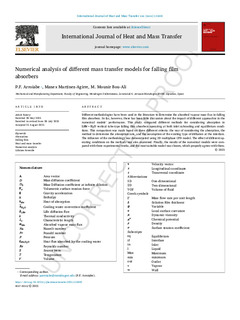
Izenburua
Numerical analysis of different mass transfer models for falling film absorbersBertsioa
Postprinta
Eskubideak
© 2021 Elsevier Ltd.Sarbidea
Sarbide bahituaArgitaratzailearen bertsioa
https://doi.org/10.1016/j.ijheatmasstransfer.2021.121892Non argitaratua
International Journal of Heat and Mass Transfer Vol. 182. N. artículo 121892, 2022Argitaratzailea
Elsevier Ltd.Gako-hitzak
Absorption
Falling-film
Heat and mass transfer
Numerical analysis ... [+]
Falling-film
Heat and mass transfer
Numerical analysis ... [+]
Absorption
Falling-film
Heat and mass transfer
Numerical analysis
Lithium-bromide [-]
Falling-film
Heat and mass transfer
Numerical analysis
Lithium-bromide [-]
Laburpena
Different methodologies have been used in the literature to determine the absorbed vapour mass flux in falling film absorbers. So far, however, there has been little discussion about the impact of dif ... [+]
Different methodologies have been used in the literature to determine the absorbed vapour mass flux in falling film absorbers. So far, however, there has been little discussion about the impact of different ap- proaches in the numerical models’ performance. This study compared different methods for considering absorption in LiBr −H 2 O vertical tube-type falling film absorbers operating at both inlet subcooling and equilibrium conditions. This comparison was made based on three different criteria: the way of consider- ing the absorption, the method to determine the absorption rate, and the assumption of the existing type of diffusion at the interface. The influence of the methodology was demonstrated using 2D multiphase CFD model. The effect of different operating conditions on the methods was also examined. Finally, the results of the numerical models were compared with three experimental works, and the most suitable model was chosen, which properly agrees with them. [-]





















